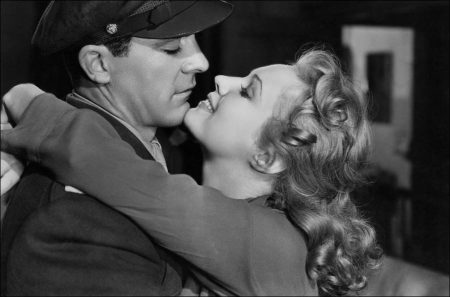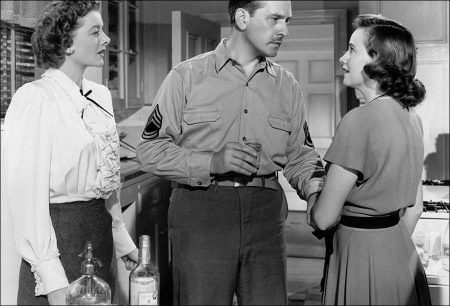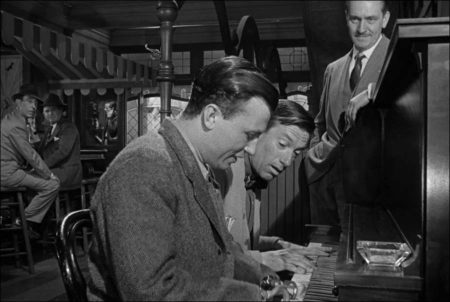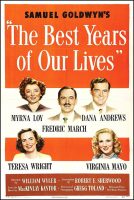The Best Years of Our Lives movie storyline. At the end of World War II, a soldier, a sailor and an airman return to their home town of Boone City and must re-adjust to the society they had left several years before. Al Stephenson was a banker before joining up. He is older than your average war veteran and gets home to find that his children have grown up and faces the difficult task of re-establishing an intimate relationship with his loving wife.
At work, Al is promoted but now finds it difficult to be the hardhearted banker he seemingly once was. Fred Derry was an Air Force Officer and Bombardier but realizes on his return that he has no marketable skills and finds himself in his old job at the pharmacy working as a soda jerk. He also finds that he had married in haste and that his wife, whom he’d only known for a few weeks when they married during his flight training, isn’t quite as enamored with him now that he’s out of uniform.
Lastly, there is Homer Parrish who lost both of his hands in a shipboard fire. He’s become quite adept at using the prosthetics the Navy has provided him but resents the pity he sees in others eyes. He had hoped to marry his childhood sweetheart but is no longer sure he can burden her with his own physical limitations. All three men become fast friends and with Fred Derry’s marriage falling apart, he finds himself falling in love with Al’s daughter, Peggy. In the end, all three finds ways to move forward with their lives.
The Best Years of Our Lives (aka Glory for Me and Home Again) is a 1946 American drama film directed by William Wyler, and starring Myrna Loy, Fredric March, Dana Andrews, Teresa Wright, Virginia Mayo, and Harold Russell. The film is about three United States servicemen re-adjusting to civilian life after coming home from World War II.
Samuel Goldwyn was inspired to produce a film about veterans after reading an August 7, 1944, article in Time about the difficulties experienced by men returning to civilian life. Goldwyn hired former war correspondent MacKinlay Kantor to write a screenplay. His work was first published as a novella, Glory for Me, which Kantor wrote in blank verse. Robert E. Sherwood then adapted the novella as a screenplay.
The Best Years of Our Lives won seven Academy Awards: Best Picture, Best Director (William Wyler), Best Actor (Fredric March), Best Supporting Actor (Harold Russell), Best Film Editing (Daniel Mandell), Best Adapted Screenplay (Robert E. Sherwood), and Best Original Score (Hugo Friedhofer). In addition to its critical success, the film quickly became a great commercial success upon release. It became the highest-grossing film in both the United States and UK since the release of Gone with the Wind. It remains the sixth most-attended film of all time in the UK, with over 20 million tickets sold.
In 1989, The Best Years of Our Lives was one of the first 25 films selected by the Library of Congress for preservation in the United States National Film Registry for being “culturally, historically, or aesthetically significant”.
Director Wyler had flown combat missions over Europe in filming Memphis Belle (1944), and worked hard to get accurate depictions of the combat veterans he had encountered. Wyler changed the original casting that had featured a veteran suffering from post-traumatic stress disorder, and sought out Harold Russell, a non-actor, to take on the exacting role of Homer Parrish.
For The Best Years of Our Lives, he asked the principal actors to purchase their own clothes, in order to connect with daily life and produce an authentic feeling. Other Wyler touches included constructing life-size sets, which went against the standard larger sets that were more suited to camera positions. The impact for the audience was immediate, as each scene played out in a realistic, natural way.
Recounting the interrelated story of three veterans right after the end of World War II, The Best Years of Our Lives began filming just over seven months after the war’s end, starting on April 15, 1946 at a variety of locations, including the Los Angeles County Arboretum and Botanic Garden, Ontario International Airport in Ontario, California, Raleigh Studios in Hollywood, and the Samuel Goldwyn/Warner Hollywood Studios. In The Best Years of Our Lives cinematographer Gregg Toland used deep focus photography, in which objects both close to and distant from the camera are in sharp focus. For the passage of Fred Derry’s reliving a combat mission while sitting in the remains of a former bomber, Wyler used “zoom” effects to simulate Derry’s subjective state.
The fictional Boone City was patterned after Cincinnati, Ohio.[6] The “Jackson High” football stadium seen early in aerial footage of the bomber flying over the Boone City, is Corcoran Stadium located at Xavier University in Cincinnati. A few seconds later Walnut Hills High School with its dome and football field can be seen along with the downtown Cincinnati skyline (Carew Tower and PNC Tower) in the background.
After the war, the combat aircraft featured in the film were being destroyed and disassembled for reuse as scrap material. The scene of Derry’s walking among aircraft ruins was filmed at the Ontario Army Air Field in Ontario, California. The former training facility had been converted into a scrap yard, housing nearly 2,000 former combat aircraft in various states of disassembly and reclamation.
The Best Years of Our Lives (1946)
Directed by: William Wyler
Starring: Myrna Loy, Fredric March, Dana Andrews, Teresa Wright, Virginia Mayo, Harold Russell, Dorothy Adams, Minna Gombell, Walter Baldwin, Steve Cochran, Marlene Aames, Charles Halton
Screenplay by: Robert E. Sherwood
Production Design by:
Cinematography by: Gregg Toland
Film Editing by: Daniel Mandell
Costume Design by: Irene Sharaff
Set Decoration by: Julia Heron
Art Direction by: Perry Ferguson, George Jenkins
Music by: Hugo Friedhofer, Emil Newman
MPAA Rating: None.
Distributed by: RKO Radio Pictures
Release Date: November 21, 1946 (United States)
Visits: 92



